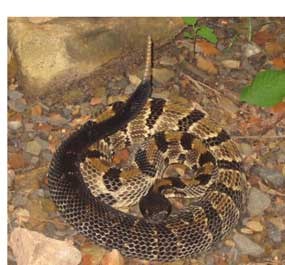
While there are many different types of snakes found at Gauley River National Recreation Area, only two types are venomous; the Northern Copperhead and the Timber Rattlesnake. Although these snakes are not normally aggressive, they can bite if surprised or threatened. Copperheads and rattlesnakes are an essential part of the natural ecosystem and an important component in the natural food chain. Please remember that snakes are protected at Gauley River National Recreation Area; it is illegal to harm them. Common Traits The copperhead and the rattlesnake share three characteristics that can quickly distinguish them from other non-venomous snakes. 1. Broad, flattened, arrow shaped heads with narrow necks, while the heads of non venomous snakes are long and slender. 2. The venomous snakes have elliptical shaped eyes similar to a cat's eye, while non venomous snakes eyes are round. 3. Sensory pits located near the nostrils are also unique to venomous snakes. Northern Copperhead Description: • Reddish brown with a series of darker hourglass or saddlebag shaped markings down backs. • Pinkish belly • 2 to 3 feet in length Habitat: Characteristics: • When agitated a copperhead may vibrate its tail rapidly in an attempt to warn off danger. 
Timber Rattlesnake: Description: • Bright yellow to dull gray in color. • Brown or black chevron shaped markings along its back. • Can grow up to 6 ft in length. Habitat: Characteristics: • Will seldom bite unless disturbed. How to avoid being bitten: • Do not place your hands or feet where you can't see. • Keep all pets on a leash. • If you see a snake, do not provoke it or try to pick it up, just avoid it. First Aid for a Snake Bite: • Stay calm; don't panic. • Look for signs of envenomation: severe burning pain at the site of the bite, swelling beginning within about five minutes of getting bit and progressing up the limb, discoloration and blood-filled blisters developing in 6 to 48 hours. In at least 25% of bites, no venom is injected. • If there are immediate symptoms, get help immediately. • Send someone for help; Call 911 • Try to keep the affected limb lowered below the victims heart • Keep the victim as quiet and calm as possible; activity can increase venom absorption. • Seek medical help even if there is no immediate reaction. All bites can cause infection and should be treated by a physician. |
Last updated: March 2, 2023
